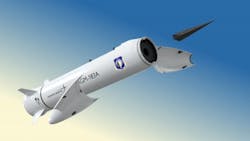Lockheed Martin to develop integrated hypersonic smart munitions to attack important relocatable targets
ARLINGTON, Va. – U.S. military researchers are asking Lockheed Martin Corp. to develop an integrated system to attack enemy relocatable time-sensitive targets like mobile ballistic missiles with hypersonic ground-launched rocket-propelled smart munitions that can penetrate modern air defense systems.
Officials of the U.S. Defense Advanced Research Projects Agency (DARPA) in Arlington, Va., announced a $58.9 million order Friday to the Lockheed Martin Missiles and Fire Control segment in Grand Prairie, Texas, for the Operational Fires (OpFires) Integrated Weapon System phase 3 program.
The contract calls for Lockheed Martin to develop the integrated OpFires system. Last July Lockheed Martin won a $7.4 million contract to develop the OpFires propulsion components.
The DARPA OpFires project seeks to enable capabilities for a mobile, ground-launched tactical weapon system able to carry a variety of smart munitions payloads to several different ranges to attack relocatable targets.
The project is a three-phase effort that consists of weapon system preliminary design, critical design, and flight testing. In October 2018 DARPA awarded a $9.5 million contract to Sierra Nevada Corp. in Sparks, Nev., to develop an OpFires hypersonic propulsion system.
DARPA officials are pursuing the OpFires project to compensate for limitations of U.S. ground forces in the effective range of surface-to-surface precision fires. OpFires seeks to provide theater level commanders with the ability to strike time-sensitive targets while providing persistent standoff from enemy counter-fire.
Lockheed Martin will focus on a hypersonic mobile, ground-launched system design, and flight test, including mobile ground launcher and all-up round. The company also will integrate the Sierra Nevada propulsion system into the final design. Flight demonstrations should be in 2022.
The OpFires prototype is not expected to meet all potential operational requirements, but will demonstrate critical system attributes, technologies, and functionality.
Lockheed Martin engineers also will identify and develop critical enabling technologies and components such as weapon command and control; booster thermal management; component technologies; launcher simulations; missile guidance, navigation and control simulations; and system safety.
On this contract Lockheed Martin will do the work in Grand Prairie, Texas; Huntsville, Ala.; and Elkton, W.Va., and should be finished by January 2022. For more information contact Lockheed Martin Missiles and Fire Control online at www.lockheedmartin.com, or DARPA at www.darpa.mil.

John Keller | Editor-in-Chief
John Keller is the Editor-in-Chief, Military & Aerospace Electronics Magazine--provides extensive coverage and analysis of enabling electronics and optoelectronic technologies in military, space and commercial aviation applications. John has been a member of the Military & Aerospace Electronics staff since 1989 and chief editor since 1995.

